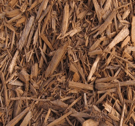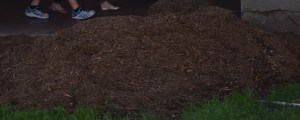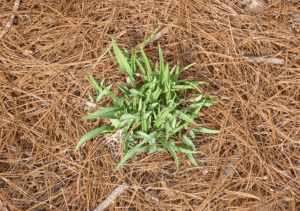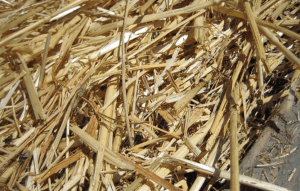Natural mulch consists of dead leaves, twigs, fallen branches and other plant debris which accumulate on the earth’s surface. Bacteria, fungi and other living organisms use these raw organic materials for food, a process we know as decay. In the natural scheme of things, decay is nature’s way of returning to the earth the raw materials borrowed by previous generations of plants.
Organic mulches not only conserve moisture, they also feed plants, earth worms, microbes and other beneficial soil life by composting at the moist earth surface. More species and tonnage of life occurs below than above the soil surface. All soil life needs energy. They cannot collect energy directly as green plants do, but the feed on energy released from decaying mulch which is their preferred food source.

As microbes digest organic materials they give off a sticky substance that glues soil particles into a crumb-like structure. Carbon dioxide-oxygen exchange necessary for healthy root growth and proliferation of beneficial soil life is enhanced. Better control of soil pathogens results.

Crumb-like or crumbly soil structure also allows water to soak in better. Water that soaks in is held on the humus and clay particles for future plant use. Water amounts higher than the field capacity of a soil is filtered by organic matter as it flows downward to feed aquifers that supply drinking water. Soils which have lost crumb structure need mulch cover to re-build.
People can adapt natural mulching to cropping practices and to production and landscape-use of ornamental plants by using available living or dead organic matter and inorganic materials. Public interest in mulch is aroused for two reasons: labor savings and plant advantages. Native materials collected in your area are the best mulch. It is neither economical nor environmentally feasible to ship in barks, wood chips or some other fancy material from a distant source when usually there are nearby materials being wasted.
Reasons for Mulching
Unfortunately, mulching does not perform instant miracles, but it encourages better plant growth and development, and makes all landscape maintenance operations easier. These benefits accrue whether plants are growing in the coolest or hottest climates or in the wettest or driest weather.
Mulch is any material placed on the soil surface to conserve moisture, lower soil temperatures around plant roots, prevent erosion and reduce weed growth. Mulches can be derived from either organic or inorganic materials.
Mulch insulates and protects soil from drying and hard-baking effects caused by evaporation of water from soil exposed to hot sun and winds. Mulched soils are cooler than non-mulched soils and have less fluctuation in soil temperature. Optimum soil temperatures and less moisture evaporation from the soil surface enables plants to grow evenly. Plant roots find a more favorable environment near the soil surface where air content and nutrient levels are conducive to good plant growth.
Mulches break the force of rain and irrigation water thereby preventing erosion, soil compaction and crusting. Mulched soils absorb water faster. Mulches prevent splashing of mud and certain plant disease organisms onto plants and flowers during rain or overhead irrigation. The mulch covering excludes light which prevents germination of many weed seeds. Fewer weeds provide less competition for available moisture and nutrients. Using mulches to control weeds is safer than applying herbicides or cultivating which can damage tender, newly formed roots. Mulches also add attractive features to landscape.
Research and common sense have shown that a high organic content favors soil microbes which detoxify pesticides after they are used and also furnishes energy needed by the microbes to make high analysis fertilizers available to plants without the fertilizer itself becoming toxic. This is another great benefit of using organic mulches. Decaying organic mulch on soil keeps both plants and beneficial soil life species flourishing so they can help each other.
Management of Mulches
Apply mulch in a layer 2 to 6 inches thick. Layer thickness depends on mulch material, e.g., coarser mulches are applied more thickly. Thicker layers of mulch are placed around trees and shrubs than in flower or vegetable beds, four inches of loose fibrous materials works well around trees and shrubs. The finer and smaller the particle size, the thinner the layer needs to be. Thick layers of very fine material block air to the roots of plants. In their search for air, roots will grow up into mulch, which can be harmful to plants if the layer of mulch is not constantly maintained. Organic mulching materials should be added regularly to maintain the desired layer thickness. Shredded branches from tree trimmings and large two-inch bark are fibrous or loose mulch. Leaves or leaves mixed with some grass clippings and one-inch size bark would be medium mulch. When using medium mulch, the layer should be about two inches thick. One-half inch and smaller materials, such as fine-screened and double-ground barks, should only be one inch thick layers. When piled to thickly, these tiny particles can quickly settle together and prevent air and water from penetrating into the soil. The finer, smaller materials should be used around small flowers and vegetables.
When applying mulch around plants, cover the entire area of soil containing roots. Do not pile mulch against tree trunks. It isn’t needed against trunks and may do harm. Donut mulch around plants to be benefited allowing the plant to be in the hole of the donut structure.
Mulches can increase availability of certain elements in the soil. Gardeners can make a synthetic chelate with mulch by mixing one cup of iron sulfate (copperas) to each bushel of mulch applied. Iron particles will adhere to the surface of the mulching material and will be released for plant use as decomposition occurs around plants. Iron sulfate treated mulches are also effective when incorporated into the soil.
When to Water
Soil moisture level is the best criterion for watering. If soil moisture is adequate, don’t water, even if a plant is wilted. To test for soil moisture, probe around plants with your finger. If the soil is moist several inches deep, i.e., will form a ball when squeezed, there is adequate moisture present.
How to Water
Knowing when to water maybe the most important part. First of all, plant soils need to be thoroughly wet not saturated. These are not swamp plants we are trying to grow. If treated as such, garden plants and most trees will respond appropriately by dying. Deep watering is desirable to insure development of deep, drought-tolerant root systems.
It is best to water plants thoroughly and deeply with drip irrigation. “Drip or trickle” irrigation is a unique method which allows precise application of water in the immediate vicinity of plant roots. Soil moisture in the root area around the plants is maintained at a uniformly optimum level throughout the growing season. Small amounts of water are applied frequently to replace that withdrawn by transpiration of water from leaves. Most water loss by evaporation from the soil IS PREVENTED BY MULCH! Growth and production of plants is greater with uniform watering (kept moist – not too wet or dry) rather than being subjected to wet and dry cycles which normally occur with other irrigation methods.
Operation of a drip system for three hours per day every other day will insure adequate soil moisture. Distribution and evaporation losses are minimized. Less of the total soil surface area is fully wetted than with sprinkler systems. Normally, only 25 percent of the soil surface is irrigated with drip. This significantly reduces the amount of water required for irrigation. This does not reduce the plant’s water requirement.
Drip irrigation also simplifies irrigation procedures and reduces labor requirements. Drip systems can be easily activated from one faucet. A drip irrigation system also waters otherwise forgotten or missed plants; once drip hose is installed around shrubs, vegetables and flowers, it never “forgets” to water – – it specifically waters each and every plant.
Drip systems are available at most local nurseries. Try one and reap the many rewards which it offers. Drip systems can be used to water during periods when drought restrictions forbid most other types of watering. However, drip systems are not fool proof and must be properly maintained for best results.
Proper Use of Mulches
In garden beds planted every year, organic mulches can be incorporated into the soil each year to improve soil structure. New mulch is applied each year. Regardless of the source of organic matter, two factors are important to the user. One is the stage of mulch decomposition and the second is relative salinity of the material. Manures and sludge’s are usually saline and may sometimes cause trouble unless used in moderation.
One question with organic mulches dependent upon the state of decomposition is whether to add a nitrogen source to the mulch. Many fresh materials may require this to avoid nitrogen tie-up.
The microbes decomposing untreated wood and bark use nitrogen. In this example some nitrogen must be added. Slow-release nitrogen fertilizers are much more effective. When required, nitrogen can be added at the rate of one-half pound of actual nitrogen per 10 cubic feet of material.
Organic Mulches
Municipal Tree Trimmings – Using local mulch (from municipal tree trimmings) around plants has certain advantages over pine or hardwood bark. The contents of the local mulch are much closer to the contents of rich compost. The local mulch blend actually feeds plants being mulched but bark usually causes nutrients to be robbed from plants being mulched.

Grass clippings – These should be used only before grass seed has ripened, must be spread thin (two inches or less) and allowed to dry. If applied too thick they will build up heat and foul odors and become slimy during decomposition.

Compost – This dark colored material is easily spread and has slight nutrient value. It may be highly satisfactory where available from commercial producers or homeowners.

Peat Moss – Fine texture and good color are characteristic of peat moss, but it has a tendency to dry out and become impervious to water. It is costly to use in large quantities. Domestic peat moss may be so finely ground that it will blow away and is difficult to wet if it becomes dry. Water may run off rather than be absorbed by it.

Pine Needles – Needles are green when fresh then turn reddish brown to gray upon drying, are long-lasting and supply nutrients as they decompose. Pine needles make attractive mulch which is good for acid-loving plants such as azaleas, gardenia, and hydrangeas.

Sawdust – If fresh sawdust is incorporated into the soil, supplemental nitrogen should be added to prevent nutrient deficiencies.

Shavings – Shavings last longer than sawdust and will not mat as badly, decompose rapidly but blow away easily during strong winds. Wood chips mixed with shavings pull much nitrogen from soil. Nitrogen level must be increased.

Straw – Straw is coarser, more durable than most kinds of hay, and in most instances, is not attractive in ornamental plantings unless chopped. Straw requires applications of nitrogen because of its non-decomposed nature.

Inorganic Mulches – Inorganic materials used for mulches do not add nutrients or humus to soil and do not decompose except after long exposure to weathering. Otherwise these materials are effective mulches, and several are permanent and quite attractive.

Crushed Rock – Crushed volcanic rock or stones are available in many colors or sizes and make a permanent cover. These materials are especially useful around plants subject to crown rot. Spread deeply, crushed rock can be walked on immediately after watering. Remember that white rock radiates sunlight and can create too much heat for most plants to survive. Black rock absorbs heat and can cause soil temperatures to be hotter than normal. A caution: Inorganic mulches of this type are exceedingly difficult to maintain and keep clean under pine or other very small-leaved evergreens.

Pea Gravel – Pea gravel is attractive permanent mulch. It is usually applied 2 to 4 inches deep and can be reused indefinitely. Pea gravel in various sizes is especially good for soil surface around plants in containers.

Quito Barajas.



